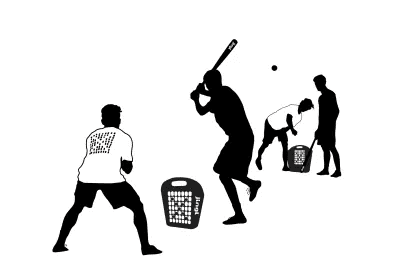OFFICIAL GAME RULES
OVERVIEW

Jingl is an action-packed, fun game that can be played recreationally or competitively, indoors or outdoors, and can be enjoyed by players of all ages.
Players engage in pitching, batting, running, catching, fielding, and throwing over the course of the game. Jingl includes two bats, a ball and two targets, or Jingls, which serve as audible strike zones and as bases that must be reached to score points. The game is played between two teams of either two or four players each.
The Offensive Team is comprised of hitter/runners and the Defensive Team takes the field as pitcher(s) and receiver(s).
OBJECTIVE

The goal of hitters is to hit the ball as it is thrown at the target and score as many runs possible (target base to target base repeatedly)
while the pitcher and receiver team tries to prevent this from happening by either throwing the ball and hitting either target (making jingl sound at contact), or catching the ball before it hits the ground.
HOW TO PLAY

SET UP
Jingl targets should be placed from 20 to 24 FT apart and face each other. This distance can be modified to accommodate players’ pitching abilities. Playing area dimensions are determined by the available space and any out-of-play areas should be determined and agreed upon by players at the beginning of the game. A coin toss or RPS decides which team hits first,
PLAYER POSITIONS
At the start of play, each Offensive Team member is stationed at a target and one is arbitrarily determined to be the first hitter. The Defensive Team members are also stationed near each target, with one assigned as the pitcher and the other as the Receiver (who is stationed in back of the batter and target being pitched to). Depending on the location of the ball, Defensive Team members perform both as a pitcher and a receiver. When the ball is pitched , the receiver fields/catches it and then pitches to the opposite hitter and target. When a hitter swings and makes contact with the ball, the pitcher and receiver work together to catch it, retrieve it and/or relay the ball back to the court to prevent the hitters from scoring additional points.
NOTE: The ball is ALWAYS “live.” This means the Offensive Team can attempt to score at any time and the Defensive Team can pitch the ball whenever they choose. Fielding errors by the Defensive Team, or their inattentiveness, can result in scoring opportunities for the Offensive Team. If, at any time, the Offensive Team players attempt to score by running for the opposite bases, or are not “SAFE,” the Defensive Team have the opportunity to Jingl the hitter/runners out. A hitter/runner is “SAFE” whenever his bat is in contact with the target. Only one offensive player per target can be “SAFE.”
PITCHING
The pitcher must be behind his stationed target when pitching to the opposite target. There is no mandatory or illegal pitching style; the pitcher is free to throw overhand, side-arm or underhand. All pitches are acceptable, including fastballs, breaking balls, and change-ups. A pitch that hits the ground first and rolls or bounces up to the target is considered good and in play. The batter can swing at and miss or tip as many pitches as it takes before he either makes a hit or jingle
SCORING
The goal of the Offensive Team is to hit the ball when it is pitched at a target and to score points by running between the two targets repeatedly without being jingled out. A point is scored each time the two Offensive Team players exchange positions by running to the opposite target and jingling it with the bat, while the Defensive Team tries to prevent this from happening by either 1) hitting either target (making a jingl sound) with the ball before both runners reach the bases, or 2) by catching a hit ball before it lands on the ground. The first team to score 21 points wins the game.
JINGLING OUT
A hitter is “jingled-out” if:
- The pitched ball hits home base (making a jingle sound), either directly, or from off the ground or tipped off the bat.
- The hit ball is caught in the air by the Defensive Team.
- A Defensive Team member throws the ball and hits either Jingl target before the hitter/runner advances to the next base and touches it with the bat.
When any hitter is jingled-out, the teams automatically trade positions.
INFRACTIONS
- If a hitter/runner obstructs the pitching or throwing path to either Jingle target or makes intentional body contact with the ball at any time, it will result in a deduction of one run.
- If a hitter/runner hits the body of any Defensive Team member with the bat, it results in ejection of that player and a game loss for hitter’s team.
- If a pitcher hits the body of the hitter (who is standing in the proper batting area) it results in an additional run for the hitter’s team.
Rules
Rules
Jingl has deep roots in Dominican Rules streetball games, combining skills from well-loved sports like baseball and cricket in a unique, Rules fast-paced hybrid create account Rules.
